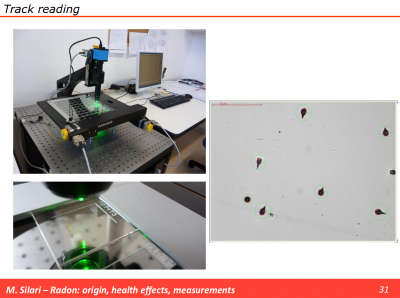Difference between revisions of "Radon measurement with DIY track detectors"
| Line 20: | Line 20: | ||
Can we use the [http://www.gaudi.ch/GaudiLabs/?page_id=652 DVD laser scanner] to see the holes? | Can we use the [http://www.gaudi.ch/GaudiLabs/?page_id=652 DVD laser scanner] to see the holes? | ||
| + | |||
| + | And could we use a DVD as detector material (Polycarbonat)? And how about modifying a DVD player to read the holes? And using old [http://www.madehow.com/Volume-1/Compact-Disc.html?fbclid=IwAR1BgVsXp1ENO7IQ40Zzs4qyFAXULKEaImdA3fyKcXYohmnLk4GstQvWOGM CDs or DVDs] from a cellar to determine the radon concentration? Make it a community science project? | ||
| + | |||
| + | People have looked into this before: | ||
| + | [https://www.sciencedirect.com/science/article/pii/S0969804312005891?via%3Dihub&fbclid=IwAR3btZCotqYo5Yk7xaBuC7zuBWTfJ9WT15Vdkk93cAr13VyGvHalu_AyE_4 Application of polystyrene films for indoor radon dosimetry as SSNTD] | ||
| + | |||
| + | [https://www.sciencedirect.com/science/article/pii/S0265931X10000391?fbclid=IwAR2UoHxjkZbrBHFVvHSOVOT-JNTlsw81cKcg8CsiScRtIp7TADCSmk1X3Jo Radon mapping by retrospective measurements – an approach based on CDs/DVDs] | ||
| + | |||
| + | echt geil | ||
| + | |||
| + | How about Electrochemical etching or Ultrasonic etching? | ||
| + | |||
| + | Let's try and meet at SDG Solution Space in Geneva for "Open Hackuarium 228 "Sans les murs" #2, Spécial Genève" | ||
| + | |||
| + | |||
Revision as of 12:10, 22 November 2018
Radon: origin, health effects, measurements, Marco Silari, CERN:
Playing with Radioaktiviät - cool.
Alpha particles form the gas or liquid shoot holes in the plastic, then you develop it to make the hole bigger. Take CR-39 Plastic (from laser googles ?) etch it with 7M NaOH, 70°C for 5h ?
1 M NaOH is 40g
NaOH is commonly used to develop photo-resist when making DIY printed circuit boards... so we should have some in the lab.
PMMA/Acryl should work as well...
Can we use the DVD laser scanner to see the holes?
And could we use a DVD as detector material (Polycarbonat)? And how about modifying a DVD player to read the holes? And using old CDs or DVDs from a cellar to determine the radon concentration? Make it a community science project?
People have looked into this before: Application of polystyrene films for indoor radon dosimetry as SSNTD
Radon mapping by retrospective measurements – an approach based on CDs/DVDs
echt geil
How about Electrochemical etching or Ultrasonic etching?
Let's try and meet at SDG Solution Space in Geneva for "Open Hackuarium 228 "Sans les murs" #2, Spécial Genève"
Links:
